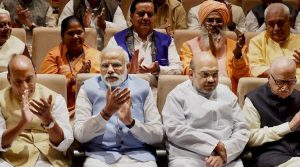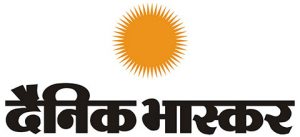
18-03-2017 (Important News Clippings)
To Download Click Here
कर क्रांति की उम्मीद से खुश हुआ भारतीय बाजार
Date:18-03-17
तय कामों में नहीं होता सेस और सरचार्ज का इस्तेमाल, फिर भी अगले साल सरकार वसूलेगी 2.8 लाख करोड़
पिछले साल 13 तरह के सेस खत्म किए गए थे, अब भी एक दर्जन सेस वसूलता है राजस्व विभाग
संसदीय समिति ने की इन्हें खत्म करने की सिफारिश

संसद की स्थायी समिति ने सेस और सरचार्ज को धीरे-धीरे खत्म करने की सिफारिश की है। उसने इसकी दो वजह बताई हैं। एक तो यह पैसा राज्यों को नहीं जाता, दूसरा जिस मकसद से लोगों से पैसे लिए जाते हैं, इस्तेमाल उस काम में नहीं होता है। राजस्व विभाग प्रत्यक्ष और परोक्ष रूप से करीब एक दर्जन तरह के सेस वसूलता है। पिछले बजट में 13 तरह के सेस खत्म किए गए थे। लेकिन इनमें हर एक से सरकार को 50 करोड़ रु. से भी कम मिलते थे। 2017-18 के बजट में 50 लाख से एक करोड़ रु. तक आमदनी वालों पर 10% नया सरचार्ज लगाया गया है।
कंस्ट्रक्शन से आए 31,734 करोड़, खर्च हुए सिर्फ 6,872 करोड़
जेटली ने कहा कि सेस और सरचार्ज इसलिए लगाए जाते हैं ताकि सरकार सड़क, स्कूल, अस्पताल आदि का निर्माण कर सके। लेकिन वास्तव में ऐसा होता नहीं। गुरुवार को श्रम मंत्री बंडारू दत्तात्रेय ने राज्यसभा में बताया कि दिसंबर 2016 तक कंस्ट्रक्शन वर्कर्स वेलफेयर सेस से 31,734 करोड़ रु. आए, लेकिन कंस्ट्रक्शन वर्करों के कल्याण पर खर्च हुए सिर्फ 6,872.51 करोड़। राज्यों को इस मद में एक से दो फीसदी तक टैक्स वसूलने की छूट है।
केंद्र के पास ही रहता है सेस का पैसा, राज्यों को नहीं मिलता
सरकार जो भी टैक्स वसूलती है, वह कंसोलिडेटेड फंड ऑफ इंडिया में जमा होता है। लेकिन सेस के पैसे इस फंड मं नहीं जाते। आम तौर पर टैक्स के पैसे में केंद्र सरकार राज्यों को भी हिस्सेदारी देती है। लेकिन सेस का पैसा केंद्र के पास ही रहता है।
टैक्स की तुलना में इसे लागू करना आसान
सेस सरकार के टैक्स रेवेन्यू बढ़ाने का आसान जरिया है। नया टैक्स लगाने या रेट बदलने के लिए टैक्स नियमों में बदलाव करना पड़ता है। लेकिन सेस को सिर्फ एक नोटिफिकेशन से लागू किया जा सकता है।
एजुकेशन सेस
इनकम टैक्स पर 2% की दर से वसूला जाता है।
हायर एजुकेशन सेस
इनकम टैक्स पर 1% की दर से लगता है।
स्वच्छ भारत, कृषि कल्याण
सर्विस टैक्स पर 0.5-0.5% की दर से लगता है।
इन्फ्रास्ट्रक्चर सेस
वाहनों पर 1% से 4% तक की दर से लगता है।
आयकर की जगह बैंकिंग ट्रांजैक्शन टैक्स नहीं
संतोष गंगवार ने बताया कि इन्कम टैक्स की जगह बैंकिंग ट्रांजैक्शन टैक्स (बीटीटी) लगाने का कोई प्रस्ताव नहीं है। यूपीए ने 2005 में बीटीटी लागू किया था। यह तय सीमा से ज्यादा पैसे निकालने पर 0.1% की दर से लगता था। लेकिन वसूली बहुत कम होने के कारण अप्रैल 2009 से इसे हटा लिया गया।
टैक्स विभाग पहले गलत डिमांड भेजता है, फिर रिफंड करता है : संसदीय समिति
वित्त पर संसद की स्थायी समिति ने असंगठित क्षेत्र से टैक्स वसूलने की संभावनाओं पर विचार करने को कहा है। इसके मुताबिक ज्यादा आमदनी के बावजूद टैक्स नहीं देने को कर चोरी समझा जाए और उस पर बड़ा जुर्माना लगाया जाए। समिति की ये सिफारिशें शुक्रवार को संसद में रखी गईं। इसमें अनावश्यक कर छूट खत्म करने का भी सुझाव है। समिति ने टैक्स रिफंड पर भी चिंता जताई है। 2015-16 में 1.22 लाख करोड़ रु. के टैक्स रिफंड हुए थे, इस साल जनवरी तक 1.41 लाख करोड़ के हो चुके हैं। समिति के मुताबिक, लगता है राजस्व विभाग पहले गलत टैक्स डिमांड भेजता है और बाद में रिफंड करता है। इससे सरकार को काफी ब्याज चुकाना पड़ता है। ऐसे टैक्स डिमांड की समीक्षा करनी चाहिए। शोम समिति की रिपोर्ट के हवाले से इसने कहा कि 10 वर्षों में प्रत्यक्ष कर संग्रह तो 700% बढ़ा है, लेकिन करदाताओं की संख्या 35% बढ़ी है। यह संख्या बढ़ाने की वित्त मंत्रालय की कोशिशें नाकाफी साबित हुई हैं। कर अधिकारियों के पद करदाताओं और रिटर्न की संख्या के आधार पर सृजित किए गए थे। अतिरिक्त पदों से अतिरिक्त रेवेन्यू नहीं आता है तो इन्हें खत्म कर देना चाहिए। इसने पान मसाला समेत कई वस्तुओं पर कर ढांचे को आसान बनाने की भी सिफारिश की है।
A new normal in UP
The triumphant narratives call for disciplining of Muslims, and for Hindu assertion.

Second, the BJP played up the ideology of nationalism and opposed Pakistan and Muslim jihadis in such a way that its campaign othered ordinary Muslims of the country in the eyes of the rest. Third, it used the tools of Hindutva to mobilise a majority of the neo-rich, middle and lower caste Hindus. By mixing Hindutva with a development agenda, highlighting either of them as the situation demanded, the party perfected its strategy to win voters.
A large section of Hindus have discovered new identities in the BJP’s strategy: They see themselves as being praised across the world for their desire for development, prudent entrepreneurship and flexibility to align with capitalist goals, as opposed to citizens of West Asia, caught in internecine battles. They are also proud of their religious identities rediscovered through Hindutva politics and defined in opposition to the Muslims. These emerging identities have been very productive for the BJP in terms of political outcomes.
To mobilise votes, the BJP and its cultural and political affiliates attempted to create new rationalities among ordinary Hindus through new narratives. One narrative claims that Hindus had lived under the despotic rule of Muslim rulers for a thousand years and secular and socialist Hindus represent a mindset which seeks to rule the country with the help of the children of Muslim despots. It also claims that the socialists and secular parties do not allow “Hindu rule” and expressions of “Hindu culture”. Another narrative translates the faster growth of the Muslim population, mainly due to poverty, into demographic anxiety among the Hindus. It fans fears that the Muslims will demographically overtake the Hindu population.
A third narrative argues that Muslim men are lustful and Hindu women and girls are not safe from prying eyes of Muslim men. A bahu-beti bachao aandolan and resistance and opposition to Muslim male-Hindu female marriages by terming them “love jihad” are strategies through which a communal divide is created. A fourth claim is the Muslims treat women only as producers of children. They do not accept constitutional provisions that assure individual rights. Lastly, the Muslim community is portrayed as full of criminals and anti-nationalists. This narrative focuses on Muslim criminals and makes them representatives of the Muslim community in India. Hindu communalists are presented as a necessary response to Muslim criminal and communal elements. During the UP election, Yogi Adityanath was presented as a counter to the likes of Mukhtar Ansari and portrayed as a protector of Hindus in eastern Uttar Pradesh. Azam Khan was accused of being a Muslim communal leader and the Muzaffarnagar riots explained as the best response to Muslim communalism.
The writer is deputy director Tata Institute of Social Sciences, Tuljapur
Date:18-03-17
By way of preface
India, and the world, are changing. Our collective responsibility — to make politics and policy more creative — grows more urgent
I had written for newspapers earlier, but serious journalism began in 1982. George Verghese, then editor of The Indian Express, asked Mrinal Datta Chaudhuri, senior professor at the Delhi School of Economics, if he would write a column on economics. Mrinal, out of characteristic generosity, and an awareness of his own work ethic, passed the buck on to me and persuaded Verghese. And I took the plunge with my column: “Economic Graffiti”. It turned out to be one of my best decisions. I was 30, more interested in economic theory and philosophy than in policy and politics. The column became my tether to the real world. I came to understand journalism’s critical role in society — that of holding our leaders and policy-makers accountable. I learnt to appreciate the huge responsibility and the commitment to truth that comes with it.
Looking back 35 years is a fascinating experience. On most days, in the ample parking area of the Delhi School of Economics, there would be just two cars, belonging to two professors. All students and most professors travelled by bus; some of the most celebrated researchers and teachers (A.L. Nagar and K.L. Krishna come easily to mind) would arrive on their bicycles.
I used to take the bus from Nizamuddin, jostling to find a foothold, let alone a seat. The bus went through Daryaganj, carts, two-wheelers and tongas rubbing shoulders with poorly-designed cars, the Government of India’s licensing system holding all competition at bay. Shopfronts jostled for space with pedestrians and vendors, and there was the signboard, Asian Institute of Something — I forget what — that added in parenthesis, to guard against the risk of losing any potential student: “(Entrance from the Backside)”.
Those were times when security was of no concern. A few years later, I bought a rickety, second-hand car. Driving to work one morning, close to Kashmiri Gate, I was caught in a traffic jam, a total standstill. Worried I would miss the PhD viva examination I was going to conduct, I got off the car, locked the door, walked out of the jam and took a two-wheeler to Delhi School. After the viva, I rushed back to the place of the jam. There was my car, in the middle of the road, autos and buses unmindfully speeding past it. India is now one of the world’s fastest-growing economies. This would have been unthinkable in my Delhi School days. We were proud of India’s open society, its vibrant media, the culture of free speech and the right to criticise the government, qualities rarely found outside advanced nations. But our economy was not something to be proud of. Over 50 per cent of the population was below the poverty line, illiteracy rates were shockingly high and growth was sluggish.
This has begun to change. Annual growth breached the 9 per cent mark for three consecutive years, starting from 2005. India’s IT sector is a world leader. And try finding parking space at the Delhi School of Economics now. All this is good news — but it is also a time of dark clouds worldwide. There is conflict and bigotry at levels not witnessed since World War II. Journalism’s responsibility is at a new high. It has to speak truth to power; it has to place the best ideas on the table — even though they may not make the writer popular. That is the writer’s predicament.
I believe one’s normative and ethical position should not interfere with one’s positive analysis. Just as a mathematician’s ideology — whether she is a socialist or a conservative — has no bearing on the fixed-point theorem she proves, whether an economist is a communist or a communalist should have no effect on his analysis of the effects of demonetisation.
I will try to keep that objectivity, but, to put all the cards on the table, my ethical sympathies are liberal. Let me explain before the trolls reach for the keyboard. I believe it is better to have an inclusive, tolerant society with individual freedom, so that people can be creative in science, the arts and in business. I believe the level of inequality in the world is unconscionable. A vastly more equitable world is possible and we must work towards that.
Yet, as they took to the streets — many of them gave up college to work among the poor — it was evident to me that it would not go well. They did not have a viable blueprint for what they were trying to build. The idealism would eventually die and a few people would capture power and wealth once again. There is no surprise that, where it was tried, the last stage of communism turned out to be crony capitalism. This is what brings me back to the enterprise of knowledge and the power of discovering ideas (not of asserting that we had them 5,000 years ago). That is what took humankind to the moon, gave us the modern vaccine and the internet. It is human creativity that enabled us to think of viable universal healthcare and social welfare. Politics and policy can be as creative as science and literature. That is our collective responsibility.
The writer, former chief economist of the World Bank, is Professor of Economics and C. Marks Professor at Cornell University


